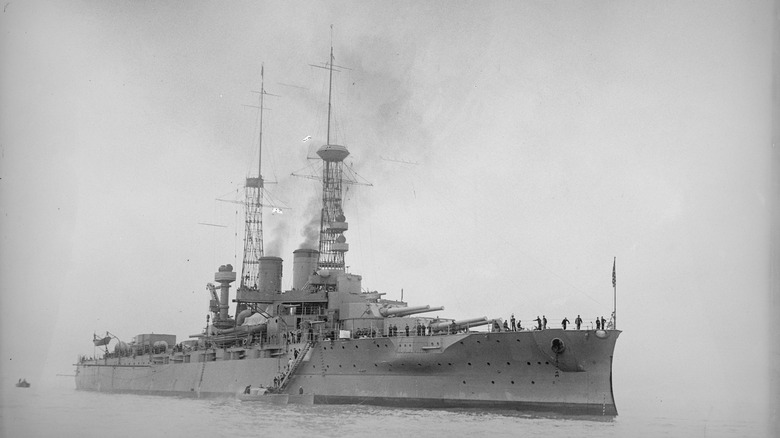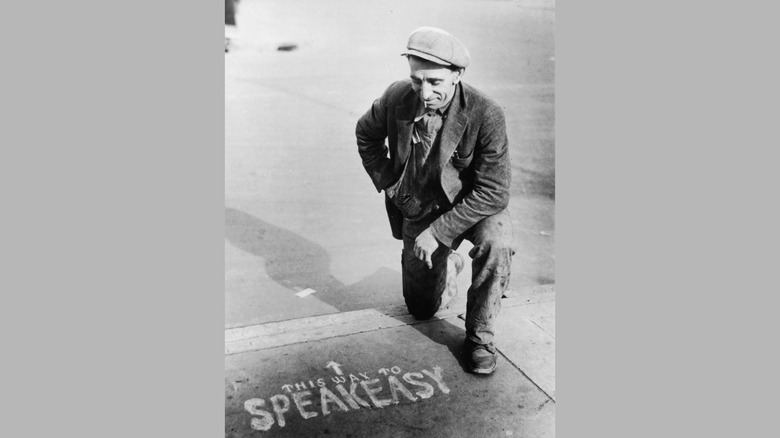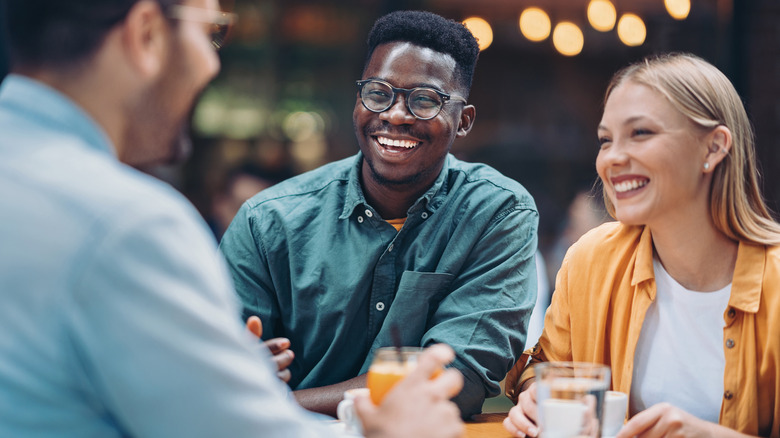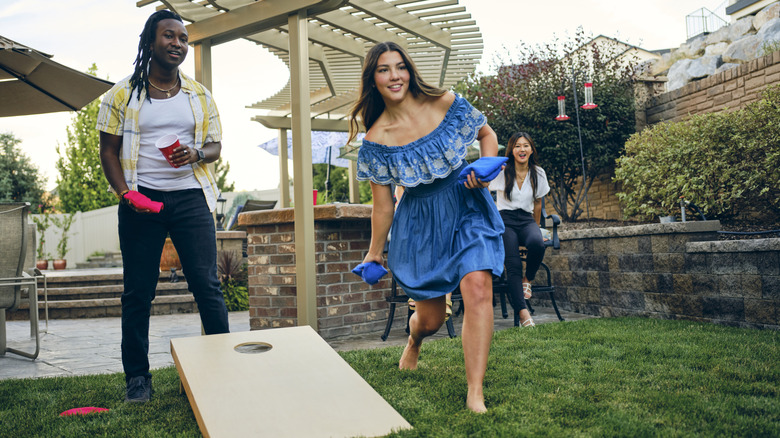Why Restaurants Introduced Happy Hour And How It Changed Dining Forever
It may conjure nostalgia from your college days, or it may just remind you of the worst hangover you've ever had, but either way, the phrase "happy hour" likely has some visceral memories associated with it. The concept, albeit a bit of a marketing ploy, promises early evening discounts on drinks and appetizers that are just too good to pass up. It's tailor-made for post-work drinks, first dates, and getting some food in your belly before a night on the town.
Like much of food history, there are multiple stories about how exactly happy hour grew into the place of reverence it holds today. It was likely popularized during prohibition — a time period during which, ironically, many alcohol-based traditions and beverages were popularized. Today, the phrase has grown to include non-alcohol-serving establishments' early evening deals, from coffee shops to kava bars to sushi spots. Regardless of its exact origins, the concept has certainly changed the way restaurant and bar dining works, extending profitable hours of operation and creating a certain twilight hour vibe that diners intentionally seek out — and retain fond memories of after the fact.
Where did the phrase happy hour originate?
Okay, the idea of having an enjoyable hour isn't exactly revolutionary — but happy hour as a nightly event began with an arguably unexpected crowd: the U.S. Navy. Although drinking alcohol onboard navy vessels or within navy yards is illegal, there's evidence that (dry) social gatherings occurred on ships such as the U.S.S. Arkansas as early as 1914. These gatherings, which were centered around competitive boxing matches, performances, and dancing were commonly called "Happy Hour Socials."
This lasted through the 1920s, varying in activity depending on whether the ships were out at sea or docked on land. The gatherings offered some much-needed levity and connection in the midst of the serious nature of sailors' jobs. A newspaper article from The Washington Times from 1914, written by an on-ship correspondent, described this "Merry Hour at Sea." The article covers moving pictures projected on white clothing bags hanging from a line; the ship's cocker spaniel mascot, Rags, enjoying the celebration; and the men celebrating "with as much abandon as though no war were in the air."
How alcohol and happy hour became synonymous
Did every alcoholic drink and tradition find its place in history during Prohibition? Surely not, but from the scofflaw cocktail to scandalous speakeasy bars that persist to this day, the 13-year period that attempted to scale down alcohol-fueled promiscuity in the United States certainly unintentionally inspired a lot of creative law-breaking — happy hour included. During this time, alcohol was not available with dinner, resulting in an old-fashioned form of pregaming before an event. In other words, couples or groups heading out for dinner would first stop by a speakeasy in the early evening for an unofficial happy hour to get in some drinks before their meal.
Speakeasies noticed and capitalized on this trend, adding discounts to alcohol or even appetizers in these slower pre-dinner hours to encourage customers to keep coming back. Today, happy hour is also sometimes referred to as cocktail hour, which may be because these mixed drinks rose in popularity during Prohibition as they were an easy way to mask the flavor of poor-quality liquor with fruit juice or other non-alcoholic mixers.
The appeal of a laidback social vibe
Of course, the main thing happy hour is known for nowadays is being one of the best ways to avoid overspending at the bar (unless you're someone who is a little too easily swayed by promotions and discounts). But today, some people specifically seek out the social vibe that happy hour creates. A far cry from the high-energy, late-night, noisy bar environment, the 3:00 p.m. to 6:00 p.m. zone is a time to share a drink with a new friend or a first date, get to know coworkers after your shift, and try a drink you haven't had before at a discounted price point — or even explore the menu of a whole new establishment.
This time is known for being social, but also low-key, and while it can serve as the precursor for a crazier night out on the town, it can also stand alone as a bit of Friday night fun that still lets you get home in time to get your full eight hours of sleep. Immediately following the pandemic, some felt that happy hour didn't have the same energy it used to, both because people simply weren't dining out as much and because with many switching to remote work, connecting in-person with coworkers has become rarer. But this might make it that much more important to take the time to invite a coworker, even one you typically speak to over Zoom, for an IRL hang at your local brewery and build that connection. Who knows? Maybe happy hour will be the origin of your next close friend.
The evolution of happy hour
Happy hour has changed a lot since the out-at-sea, secret doorway days. For one thing, it's no longer illegal (at least, in most states); you can send your thanks to the 21st Amendment to the Constitution for that one. Happy hours also now often stretch from the late afternoon through early evening, and they're sometimes limited to only certain days of the week or offer different specials depending on the day. Beyond that, other establishments have hopped on the train of pre-dinner discounts, with specials on coffee, sushi, and more ready to fill that awkward gap between your afternoon and evening meals without hitting your wallet too hard.
Over the years, restaurants and bars have also added new twists in an effort to make the early evening hours a can't-be-missed event. Sometimes, this means that happy hours come with a theme or activity, be it trivia night, industry-worker-specific discounts, or Taco Tuesday, while other times it means they bring out cornhole and cards — or even invite local bands to play live for a special once-a-week performance. Bottomless mimosa happy hours, dog-friendly happy hours, family-friendly happy hours, and any number of other creative variations dreamed up by intrepid marketing interns round out the list of possibilities, all working together to make the establishment the most money — and make the customer most excited to come back.




